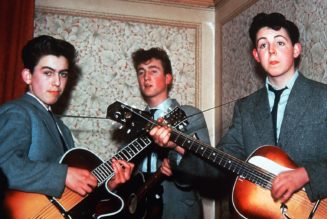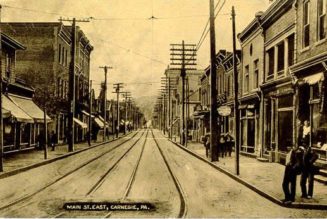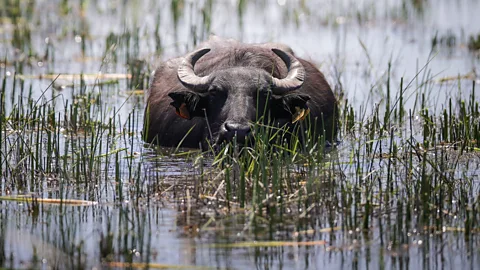 Getty Images
Getty ImagesWhen water buffalo make a home for themselves in abandoned spaces, they can bring with them a rich array of frogs, bats and plant life.
Each autumn, as tadpoles outgrow their tails, the Kizilirmak Delta on Turkey’s Black Sea erupts into chaotic commotion with the emergence of marsh frogs. While the fist-sized frogs are at home in the delta’s wetlands, dozens can be seen hopping out of the muddy waters to exploit one particularly strange and unusually lively hunting ground.
Climbing up a hillside of thick fur, the frogs encounter terrain that’s warm underfoot and an atmosphere that buzzes with flies. But there are risks to foraging here. The surface beneath their webbed feet twitches and shakes, and the entire floor is prone to lurching unpredictably through the air and collapsing into the mud.
This moving mountain of brawn and bugs is the muscular back of a massive water buffalo. On each of these giants roaming the delta, as many as 20 frogs or more can be found hitching a ride to their next meal.
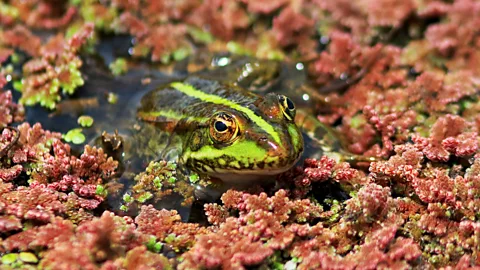 Getty Images
Getty ImagesIn this – the first observed example of amphibians foraging on the body of a large mammal – Turkey’s marsh frogs have capitalised on one of the peculiar benefits that these huge animals bring to their wetland environments: their knack for attracting flies. Yet the frogs are just one of countless species worldwide, from bats to bog grasses, finding their surroundings transformed and their fates improved by the presence of buffalo.
Over the course of more than 3,000 years since the water buffalo were first domesticated in Asia, these half-tonne mammals have spread around the world. Today they are estimated to number more than 200 million across 77 countries on five continents. For generations they were prized as powerful plough-pulling draft animals and providers of nutritious milk. In recent years buffalo have begun to earn a reputation among conservationists as handy landscape managers and a crucially important ecosystem engineer.
Built for wetlands
Not to be confused with the bison of the American plains (often known as “buffalo” in North America), Asian water buffalo evolved to thrive in wetlands. They have wide, splayed hooves “like mini-shovels that spread out” to give them traction in damp and boggy land, says Alan McElligott, an associate professor of animal behaviour and welfare at City University of Hong Kong. This solid footing, plus flexible joints around their ankles, allows them to comfortably cross swamps, marshes and floodplains where most domesticated animals, like cows and horses, fear to tread.
In thousands of years since domestication, buffalo have been selectively bred and today the United Nations Food and Agriculture Organization recognises more than 100 specially adapted breeds. Buffalo can be broadly divided into river buffalo, which are common in India, the Middle East and Eastern Europe, and smaller swamp buffalo, found across Bangladesh, China and Southeast Asia. River buffalo have often been bred for milk and typically prefer deep water, while swamp buffalo are usually bred as draft animals and are happiest wallowing in mud puddles. Breeds range from the heavy, hairy Romania buffalo (a river breed that can survive hard winters) to the Buffalypso, the swamp-river crossbreed that was bred to live on sugar plantation scraps in the hot Caribbean climate of Trinidad.
“They’re big. They’re not selective feeders. They have a very broad mouth,” says McElligott. This helps them make light work of a variety of nutritionally poor aquatic plants and grasses, he says.
Domesticated buffalo have long had a justified reputation as gentle giants, McElligott says, which remains largely true of Hong Kong’s population, the “feral” descendants of farmed buffalo which now roam free. Conflicts with humans do happen, such as when males fight during mating season, McElligott says. But water buffalo can be docile enough to ride, as demonstrated by one Brazilian police force.
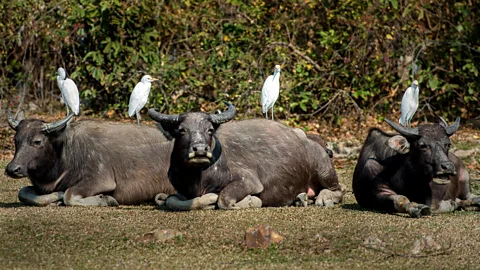 Getty Images
Getty ImagesIn Hong Kong, where many rice paddies have been abandoned amid intense urbanisation, former rice farms that are now grazed by buffalo have been found to have greater biodiversity than rice fields without the bovines. But City University’s project aims to build a better picture of how free-roaming feral buffalo – the escaped descendants from livestock that pulled ploughs on rice paddies – act as keystone engineers of Hong Kong’s wetlands.
On a walk around Lantau Island, a short subway ride from the skyscrapers of central Hong Kong, McElligott sees buffalo traces all around. The animals dig wallows – ponds or mud puddles – to keep cool and protect them from biting insects. During the rainy season, these are filled with small insects, amphibians and fish, McElligott says. “In the summer, lots of invertebrates are probably breeding in those things.” The invertebrates are food sources for frogs and likely by reptiles such as snakes, he adds.
Despite the water buffalo’s global spread, crucial information about the bovines, such as population distribution and their precise impacts on aquatic systems, remains unknown. When feral populations grow to excessive numbers, with few predators to keep numbers in check, the ecological impacts can be disastrous. In Australia’s Northern Territories, there are estimated to be more than 200,000 feral buffalo, which can damage and divert waterways and disturb native geese. Along with feral horses, donkeys and cows, they have contributed to declining biodiversity.
Indeed, the disturbance that buffalo bring isn’t always welcome – as one family in Essex, eastern England, found out when they awoke to find 20 wallowing in their swimming pool – but for some landscapes it can make a critical difference.
Living tractors
In the right environmental context, buffalo act as “conservation grazers”, says Sara King, an ecologist at Rewilding Britain. In England and Wales buffalo are kept behind fences to manage wetland and pasture that has become overrun with reeds or scrub forest. There, they can chew back vegetation that would otherwise smother biodiversity. “They create this mosaic of open areas through their grazing,” says King. By eating, wallowing, trampling and spreading dung, they further increase the diversity of microhabitats on offer for species, including invertebrates and water birds, she adds. “So it really does bring back quite a lot of life.”
In many places, conservation projects are bringing back animals that fell from favour as livestock in the 20th Century. In Ukraine’s Danube Delta, a breed of Carpathian buffalo was employed as an all-purpose “living tractor” for centuries until the Soviet Union implemented mechanised collective farming in the 1930s. By the turn of the millennium, their numbers had dwindled. But two Ukrainian projects have restocked the herd to help bring wetlands back to an island in the Danube, which had been drained for farming, and support the return of rare daffodil species.
Elsewhere, including post-industrial landscapes of Slovenia, conservation projects have transported buffalo onto unfamiliar terrain. Damijan Denac, chief executive of the nonprofit Birdlife Slovenia, was one of a group of environmentalists who took on a major challenge when the Ormož Sugar Factory, on the Drava River, closed in 2006. During its heyday in the 1990s, the factory became an unusual haven for birdlife, with cooling ponds that received a steady supply of wastewater from cleaning raw sugar beets. These ponds, which carried heat and residual sugars from the factory, provided a bug buffet and ideal resting spot for migratory waterbirds, including the Common Tern and the Black-headed Gull.
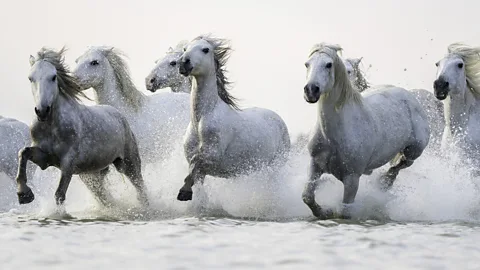 Getty Images
Getty ImagesAfter the factory closed, its owners donated the site to environmentalists, who developed a set of thrifty tactics to turn this 55-hectare (140-acre) wetland into a nature park, such as hacking shipping containers to become bird-spotting posts.
After a few seasons when volunteers laboriously mowed fast-growing foliage around the basins, it was clear that this task would be impossible without the assistance of large grazing animals, says Denac. “And we knew that we would need a lot of animals – 30-plus.”
Denac says the project considered importing Camargue horses, a breed of “water horses” that lives in marshes in southern France, which had been used on coastal restoration projects in Slovenia. But he was convinced to opt for buffalos by conservationists working on similar wetlands in Neusiedler-See National Park in neighbouring Hungary, and soon recruited four females and one male as conservation grazers.
This bet on bovines paid off as buffalo waded through thick scrub and silty ponds to eat plants that had choked the water, wallowed on banks that had become overgrown with reeds, and cleared ditches that were previously dredged with industrial machinery. As in neighbouring Hungary, buffalo suppressed an invasive species of American goldenrod, allowing diverse native grassland species to return.
In addition to saving on mowing costs, it is possible to see the direct impact they have in attracting animals: cattle egrets follow them around, eating everything from ticks to the frogs and insects they flush out as they move. Yet the indirect impacts of the ecosystem engineering are often the most dramatic, says Denac. Last summer, camera traps showed the new occupants of an open area cleared by buffalo, with visits from badgers, otters, cormorants, herons and more.
Ancient revival
While some projects, like the Ormož reserve, are relatively closely managed (using moveable fences to guide buffalo to graze certain areas), others aim to let buffalo run loose. Rewilding projects – which typically aim to restore ecosystem functioning by returning wild megafauna – often see water buffalo to be a worthy stand-in for the many large animals that have vanished from the landscape, King says. According to Rewilding Europe, a pan-European rewilding charity, the water buffalo’s physical impacts – as well as transporting seeds around in their fur and gut – can fill in roles left absent by the extinction of massive wild herbivores, including the European water buffalo, which died out more than 10,000 years ago, and more recently disappeared creatures.
King is also keenly observing an emerging alliance at one site in Cumbria where non-native water buffalo have been introduced alongside Eurasian beaver, which was native to the UK but has been absent for hundreds of years. Where the rodent’s dam-building creates pools, buffalo then wallow, adding further complexity to the habitat.
“It’s going to be really interesting to see those interactions and see how the two species complement each other,” says King. “And also to see how the two of them in a wetland system then support opportunities for other species as well.”
Wetland stewards
Globally more than one third of wetlands have disappeared in the last 50 years. But with buffalos’ help, more post-industrial spaces could have potential to develop into semi-natural swamps.
CARBON COUNT
In Turkey, some 500 miles (800km) along the Black Sea coast from Kızılırmak, abandoned 20th Century coal mines have been filled with rainwater. For decades, local herders, who farm buffalo for their milk, released the animals to traverse this area carving channels between pits for fish, frogs and other species, which in turn fed the area’s flocks of migrating birds, explains artist Alon Schwabe. Schwabe co-leads Cooking Sections, a London-based creative duo that has researched the Istanbul marshes and organised a yearly water buffalo festival to highlight the herding communities’ struggle for survival in the face of Istanbul’s sprawling development.
With heavy development in the area already, and a planned 45km (28-mile) canal through this area that would allow ships to bypass the busy Bosphorus shipping corridor, pastoralists’ way of life is precarious. Despite being greenlit by Turkey’s environment ministry in 2021, the plan to cut a 400 metre-wide canal will cut through farmland, marshes and forests, would cause irreparable damage to the environment and water systems, as well as worsening traffic congestion,an Istanbul court ruled in February. A spokesperson for the Turkish government declined to comment due to ongoing legal proceedings.
The unique relationships that buffalo have developed with both Kızılırmak’s frogs and Istanbul’s herders have emerged as a result of winding histories in which buffalo have crossed continents, provided food sources and ploughing power, and been released to roam free. By helping to rehabilitate post-industrial landscapes and rewild the countryside, the world’s 200 million buffalo are cementing now their place as the gentle giants, destructive creators, and the introduced species that feels at home across so much of the planet.
For more science, technology, environment and health stories from the BBC, follow us on Facebook and X.





